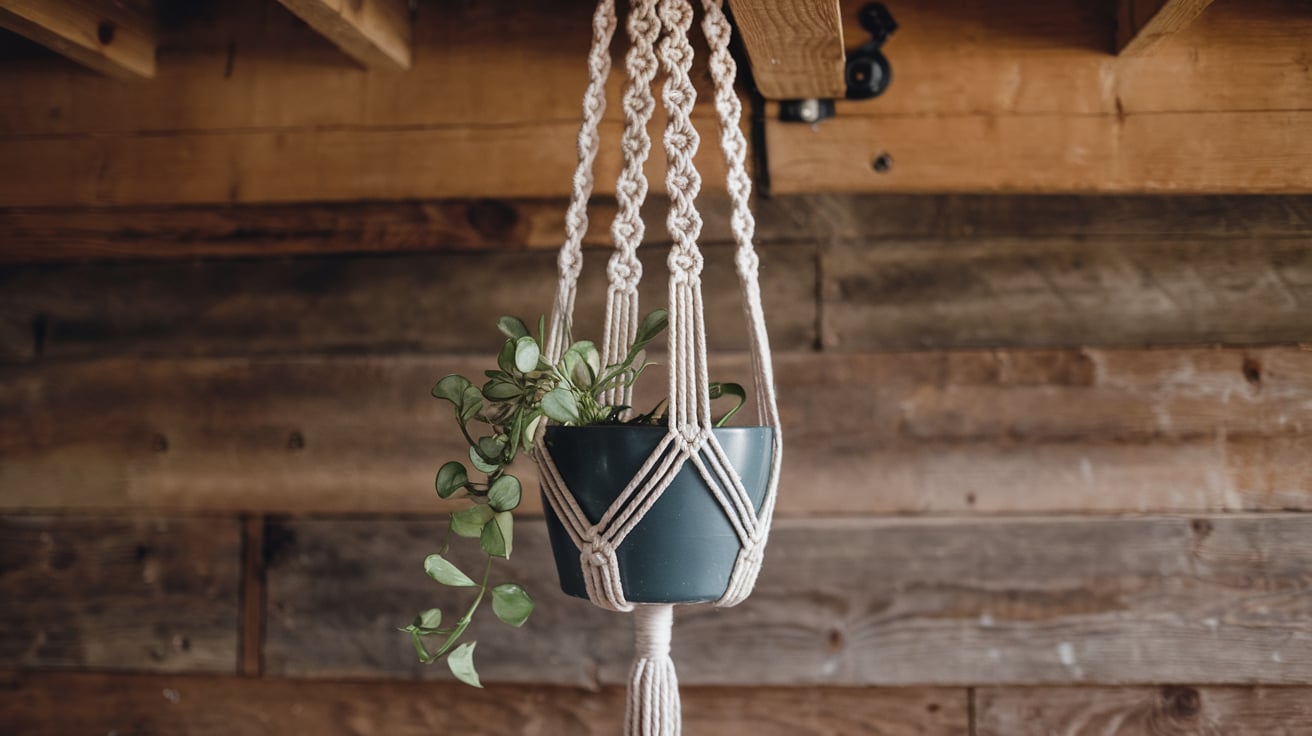Creating beautiful plant hangers doesn’t have to be complicated or expensive. Like many plant enthusiasts, I struggled to find stylish ways to display my growing collection without breaking the bank.
The solution? Macrame plant hangers add texture and bohemian charm to any space.
In this guide, I’ll show you exactly how to create a stunning macrame plant hanger using simple materials and basic knotting techniques. Even if you’ve never tried macrame before, you’ll be able to follow along.
I’ll walk you through each step of the process, from selecting the right cord to finishing the fringe, complete with pro tips and common mistakes to avoid.
Let’s transform your plant display game today!
Macrame Plant Hanger Step-by-Step Instructions
Tools and Materials Required
| Item | Type | Details |
|---|---|---|
| Cords | Material | Multiple cords, including two longer ones for the outer edges |
| Wooden ring | Material | Used at the top to hang the plant hanger |
| 24-inch cord pieces | Material | Two separate pieces, used for wrapping knots |
| Scissors | Tool | For cutting excess cord and tucking ends |
Step 1: Prepare the Cords
Begin by threading all your cords through the wooden ring.
Position the two longer cords on the outer edges, one on the left side and one on the right side. Then fold all the cords in half so they’re centered through the ring, creating an even distribution of cords hanging down.
Pro Tip: Lay out all your cords before starting to ensure they’re the correct lengths, and use a bit of tape to temporarily secure the ends of your cords to prevent them from slipping through the ring during the initial setup.
Common Mistakes to Avoid:
- Not identifying the longer cords correctly before threading will affect the entire project.
- Uneven folding causes asymmetry in your final piece.
Step 2: Create the Spiral Knot Section
Take the two outer longer cords and use them to tie 25 half-knots in sequence to create a spiral pattern.
A half knot is made by crossing the left cord over the center, then bringing the right cord behind and through the loop.
Unlike a square knot, where you alternate sides, for a spiral, you continue tying from the same direction each time. This consistent direction creates a spiral effect as you tighten each knot.
Pro Tip: Maintain consistent tension throughout all 25 knots for a uniform spiral. Count your knots as you go to ensure you reach exactly 25 for balanced proportions.
Common Mistakes to Avoid:
- Switching the direction of your knots mid-spiral, which breaks the spiral pattern
- Tying some knots too tight and others too loose, creating an uneven spiral
Step 3: Tie the First Wrapping Knot
Grab one of your 24-inch pieces of cord and create a U-shape by holding the cord against the bundle with the short end sticking up on the left.
Take the longer right side and wrap it around the bundle about 6 times (you can adjust this number based on your preference). After wrapping, thread the end through the U-loop at the top and pull the short end to tighten, bringing it halfway under the wraps.
Cut off any excess cord and use your scissors to tuck the ends neatly under the wraps.
Pro Tip: Keep your wrapping cord flat (not twisted) as you wrap for a clean, professional finish. Pull the short end slowly and carefully when tightening to prevent breaking the cord.
Common Mistakes to Avoid:
- Pulling the cord all the way through instead of halfway, which will undo your wrapping knot
- Not keeping the wraps tight and close together
Step 4: Create First Row of Square Knots
Measure approximately 12 inches down from the wrapping knot you just tied. Divide all your hanging cords into groups of four.
Tie a square knot in each group, making sure the tops of all your square knots are aligned at the same height for a clean, professional look.
When completed, you should have four square knots, evenly spaced around the circumference of your plant hanger.
Pro Tip: Use a measuring tape or ruler to mark the 12-inch point on each cord group before tying to ensure perfect alignment. Consider using clothespins or clips to group your cords into sets of four temporarily.
Common Mistakes to Avoid:
- Tying square knots at inconsistent heights, resulting in a crooked plant hanger
- Mixing up which cords belong in which groups
Step 5: Create Second Row of Square Knots
Measure 3 inches down from the first row of square knots. For this row, you’ll tie square knots in between the previous knots, creating an alternating pattern.
This technique connects the plant hanger’s “arms” and forms the basket-like structure that will hold your plant pot.
Continue this pattern all the way around, maintaining an even height for all knots to ensure your plant hanger hangs straight.
Pro Tip: Before tying this row, gently stretch out your work to ensure the first row of knots is evenly spaced, which will make this alternating row much easier to execute properly.
Common Mistakes to Avoid:
- Forgetting the alternating pattern and tying knots directly below the first row
- Inconsistent spacing between knots that causes the basket to be asymmetrical
Step 6: Tie the Bottom Wrapping Knot
Measure 3 inches down from the second row of square knots and prepare to tie another wrapping knot. Use your other 24-inch cord piece to make a U-shape against the bundle of cords.
Wrap the longer end around 6-7 times, then thread it through the loop you created. Pull the short end halfway under the wraps to secure it. Cut off any excess cord and tuck the ends underneath for a clean finish.
Pro Tip: Gather all cords tightly together and hold them firmly in place before beginning your wrapping knot to create a neat, compact bottom closure.
Common Mistakes to Avoid:
- Not gathering all cords together evenly before wrapping
- Inconsistent tension in your wraps that creates a sloppy appearance
Step 7: Finish the Fringe
Complete your plant hanger by cutting the bottom cords to about 5-6 inches. You can either leave the ends as they are or unravel them to create a decorative fringe effect.
This final touch adds a beautiful bohemian look to your macrame plant hanger while also neatly finishing the bottom edge.
Pro Tip: For a more polished look, cut all fringe ends on a flat surface using sharp scissors to ensure they’re perfectly even. To create fuller fringe, use a fork to gently comb through the unraveled cords.
Common Mistakes to Avoid:
- Cutting the fringe too short, which can make the plant hanger look unfinished
- Uneven cutting that creates a jagged bottom edge
I’d like to give credit to Marching North for their informative video, which served as a reference for this guide.
A Step into Sustainability: Eco-Friendly Macrame Plant Hangers
Making your macrame plant hangers eco-friendly is good for the earth, but it also gives your creations more character and a story to tell.
Imagine telling friends, “This plant hanger? I made it from an old T-shirt I was about to throw away!”
Each time you choose natural materials or reuse something old, you’re taking a small step toward a healthier planet. And the best part? These eco-friendly choices often create more beautiful, unique pieces than store-bought materials ever could.
Ready to try it yourself? Let’s look at some simple ways to make your macrame more earth-friendly:
- Use cotton, jute, or hemp cords instead of synthetic ones; they break down naturally and don’t release harmful chemicals
- Turn old t-shirts into “yarn” by cutting them into strips. This creates super soft hangers with a beautiful texture
- Try those wooden beads sitting in your craft drawer instead of buying plastic ones
- Look for wooden rings from fallen branches or sustainable sources
- Skip the toxic dyes and try coffee, tea, or plant-based dyes for natural colors
The natural look of these materials brings a warm, organic feel to your home that plastic can’t match. Plus, there’s something special about creating beauty from items that might have ended up in the trash.
Long-lasting and Reusable Design
Have you ever bought something cute that fell apart after just a few weeks? It’s frustrating. That’s why I love making macrame plant hangers that actually last for years, not months.
The secret to creating plant hangers that stand the test of time isn’t complicated; it’s all about taking a few extra minutes to do things right. And trust me, your future self will thank you!
Why Build to Last?
When I first started making macrame, I rushed through my knots, just wanting to finish quickly. The result? Plant hangers that stretched out of shape or unraveled after a few months. One even dropped my favorite pothos plant!
Now I know better. A well-made macrame hanger can last for decades, not just seasons. My grandmother still has one from the 1970s hanging in her sunroom!
Here’s how you can make your plant hangers super durable:
- Choose strong, thick cords that won’t snap under the weight of your plants
- Double-check each knot as you go, making sure it’s tight and secure
- Use sturdy rings that won’t bend or break
- Add extra security knots in spots that hold the most weight
- Keep your design simple but strong; sometimes, less is more!
The best part about making long-lasting plant hangers is that you can change them up whenever you want! You can move them to different rooms, switch out the plants, or even give them a gentle wash when they get dusty.
Conclusion
You now have all the steps to make a beautiful, planet-friendly macrame plant hanger that will last for years to come. By choosing natural materials and taking time with each knot, you’re not just making a pretty home for your plants; you’re also making a choice that helps our world.
Remember, the care you put into your knots today means stronger hangers tomorrow. And the earth-friendly materials you pick make each piece truly one of a kind.
Ready to get started? Grab your cords, find your wooden ring, and enjoy the simple joy of making something both useful and beautiful with your own two hands.
Share a photo of your finished hanger in the comments. I’d love to see what you create!
Frequently Asked Questions
1. How much Macrame Cord do I Need for a Plant Hanger?
Depending on your pot size and design, you’ll need about 4-5 strands of cord, each 8-10 feet long. Add extra length if you want a longer fringe at the bottom.
2. What is the Rule of Thumb for Measuring Macrame Cords?
For macrame plant hangers, measure cords 4 times the finished length you want. For wall hangings or more complex projects, use 6-8 times.
3. What String Should Be Used for A Macrame Plant Hanger?
Cotton cord (3-5mm thick) works best for plant hangers. You can also use jute, hemp, or recycled t-shirt yarn. Choose natural fibers that are strong enough to hold your plant’s weight.















